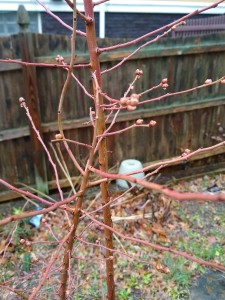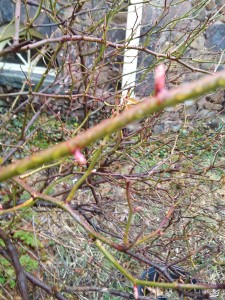 In Western New York, where I grew up, we did not put away our winter clothes until Memorial Day. Now I live in a gentler climate and when the “official” first day of spring arrives, I expect the garden to be well on its way to mid and late spring glory. We have had a few balmy days since the start of March, but mostly the month continues to roar like a lion. The plants are emerging cautiously, still buffeted by the cold winds and shivery in the low night temperatures.
In Western New York, where I grew up, we did not put away our winter clothes until Memorial Day. Now I live in a gentler climate and when the “official” first day of spring arrives, I expect the garden to be well on its way to mid and late spring glory. We have had a few balmy days since the start of March, but mostly the month continues to roar like a lion. The plants are emerging cautiously, still buffeted by the cold winds and shivery in the low night temperatures.
Still, it is time to start my spring ritual of looking for signs of life among the plants. Every year the results of this inspection are the same. Some plants that look completely dead will have survived, while others that I thought were sturdy, protected, and well mulched may be either deceased or nearly there. The key right now is finding out which is which–a kind of seasonal garden triage effort.
The big tree peony by my driveway has raised my spirits by flaunting plump buds on every stem. Those buds don’t seem affected by the ongoing cold siege and I am looking forward to seeing the big, dark red blooms sometime in late April.
The last few winters have not been kind to my roses, with some of the biggest and best losing so many canes that they are now shadows of their former selves. Two weeks ago, one of the healthiest roses in the garden, the hybrid musk, ‘Pax’, which would grow strongly in a toxic waste dump, lost one of its biggest canes to an avalanche of wet snow. Fortunately, the rest of ‘Pax’ is still in rugged good health and will barely miss the departed cane. I expect that by June it will be even bigger than it was last fall. The vigorous ‘Ghislaine de Feligond’ in the back
garden has the long slender canes of a would-be rambler, and each one is covered with swelling buds.
All the roses need a good pruning because even the best of them have suffered at least some amount of winter damage. The pruning sessions will let me get up close to every cane and check for health.
The hydrangeas worry me. The majority of mine are that old favorite, ‘Nikko Blue’. They set strong buds on last year’s wood, but those buds are highly susceptible to the kind of cold spring winds that we have had in abundance lately. Two years ago the spring breezes froze those buds and my three big hydrangeas produced exactly one flowerhead in early summer. Last year, flower production was back to normal, but who knows now? The buds seemed alive when I checked them yesterday, but cold wind is predicted for the next day or so. The jury is still out.
Hellebores are tough plants and almost always survive winter. A parting of the dead maple leaves that surround mine reveals that some have given birth when I wasn’t looking. The Christmas rose or Helleborus niger has burst into bloom and thumbs its nose at cold wind. The many Lenten roses—Helleborus x hybridus—are blooming now too, but last year’s tattered leaves diminish their glory considerably. Clipping that shopworn foliage will reveal new foliage growing underneath and allow the nodding flowers to shine. It takes about five minutes to give each mature hellebore the necessary haircut. Even if I have to work in short time increments, I can get them under control in short order.
The jury is also still out on the butterfly bushes or Buddleia davidii. They don’t bloom until summer and do not waste their time doing much of anything in early spring. Even if the branches freeze like strands of marble, the healthy bushes will produce flowers on new wood. I am a little worried about the oldest of them, because it has sustained substantial damage to its base in years past, with the trunk splitting and the branches splaying out at unnatural angles. Last year I pruned it back hard, but it still struggled and didn’t bear anything like its usual number of dark purple flower panicles. It has always been a magnet for the various butterflies, skippers and hummingbirds that frequent the yard, so I hope it can make a comeback.
Garden pundits always say that a dead plant is not a failure, but an opportunity to grow something new. I believe that intellectually, but tend to take it personally when plants perish. I am hoping for the best this year and am ready to perform heroic rescues on faltering abelia or woebegone daylilies. When the wind finally stops howling, my arsenal of clippers, loppers, sticks and string are ready to go.
